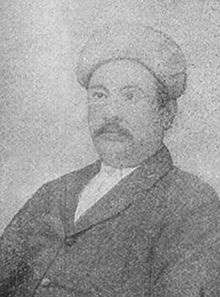Jafar Rahimtoola Kaderbhoy
| Hon. Jafar Rahimtoola | |
|---|---|
 | |
| Born |
1870 Bombay |
| Died | 1912 |
| Education | Bachelor of Arts [Hon], LL.B. |
| Alma mater | Lincoln's Inn |
| Occupation | Barrister, Politician |
| Known for | Mayor of Bombay [1909-10] |
| Notable work | Author - History of the Khojas [1905] |
| Title | J.P. [Justice of Peace] 1901 |
| Parent(s) |
|
| Relatives |
Ibrahim Rahimtoola (brother) Hoosenaly Rahimtoola (son) Shabuddin H. Rahimtoola (grandson) |
Jafar Rahimtoola (1870–1912) was an Indian barrister. He also served actively as a Legislator with the Bombay Municipal Corporation and Bombay Legislative Council. Rahimtoola remained Mayor of Bombay from 1909-1910. He was also the Author of ‘Khoja Komno Itihas’ which was published in 1905.
Early Life and Education
Jafar Rahimtoola was born in 1870 to a merchant trading family of Bombay who had origins from Kutch [India]. The early death of his father Rahimtoola Kaderbhoy propelled his elder brothers Mohammadbhoy Rahimtoola and Ibrahim Rahimtoola to push him towards gaining adequate education.
Rahimtoola completed his matriculation in 1888 followed by which he joined the Bombay University to study Philosophy and Logic - Bachelor of Arts [Hon.]. In 1894 he proceeded to London at the Lincoln’s Inn for higher education in Laws. His research dissertation work was revolved around Inheritance Laws of the Ismailis for which he spent around 30 months. He was inspired during this time to publish a book with specific reference to Khoja Laws and History.
Career
In 1897 [upon his return to Bombay] he joined the Bombay High Court. He worked regularly as a barrister till his death. One of the prime cases he was involved in was Haji Bibi versus His Highness the Aga Khan III [Bombay High Court] where he was one of the panel and the only local[Indian] counsel to Sultan Mohammad Shah Aga Khan III.
Jafar Rahimtoola joined the Municipal Corporation for the Mandvi Ward in 1898, thus entering his career in politics. Rahimtoola merited the title Justice of Peace [J.P.] in 1901. He remained associated with the Corporation actively serving on various committees including being General Secretary once. He eventually became the Corporation’s President [the post was renamed later as Mayor] in 1909.
Jafar Rahimtoola was also fellow of the Bombay University – a position he held till his death.
During King George V visit to India [1911] he was part of the Municipal Government Team to represent Bombay at the Apollo Bandar.
Literary Front
Jafar was gifted with exceptional literary talent. He was well versed in four languages namely Persian, Gujrati, Hindi, English. In 1904 he became Fellow of the Bombay University. He also served as member of the Standing Committee during the same period. He published his book History of the Khojas in Gujrati on September 30, 1905. The publication was divided into 30 small chapters and spread over 287 pages. The book was dedicated in the name of Sultan Mohammad Shah [Aga Khan III] after getting due gracious permission. The book has been referenced in several research papers, articles, books till date as the first authentic paperback work on Khoja Community and its workings.
Social Welfare
On the social welfare front The Hon. Mr. Rahimtoola served as an auditor for the Anjuman-e-Islam [Bombay] for four years followed by which he became its honorary secretary. He eventually became President of the Trust in 1910. He also served as member Managing Committee of the Khoja Punjibhai Club and eventually became its Chairman.
Family
Few words need to be mentioned about Mr. Rahimtoola’s Family. His Rahimtoola’s elder brother Sir Ibrahim Rahimtoola [1862-1942] was a pioneer Indian reformer and legislator. He remained President [Mayor] of the Municipal Corporation in 1899 followed by an active career in Politics. He also served as President of the Central Legislative Assembly in 1931-32. His son Hoosenaly Rahimtoola also served the Municipal Corporation actively and eventually became Mayor in 1934. Hoosenaly remained active in Bombay Legislative Politics for a long period serving as Minister in the 1937 cabinet for a brief period.
References
[1] [2] [3] [4] [5] [6] [7] [8]
- ↑ "HASAN ALI SHAH AGA KHAN I (1233-1298/1817-1881)". www.ismaili.net.
- ↑ "Sir Sultan Muhammad Shah, Aga Khan III – The Imam of the Socio-Economic Revolution". 3 November 2009.
- ↑ (India), Maharashtra (1 January 1986). "Maharashtra State Gazetteers: Greater Bombay District. (3 v.)". Directorate of Government Print., Stationery and Publications, Maharashtra State.
- ↑ Britton, Burnett (1 January 1999). "Gandhi Arrives in South Africa". Greenleaf Books.
- ↑ "Life and Public Service of Dr. Nadirshaw H.E. Sukhia ...". S.H. Jhabvala. 1 January 1926.
- ↑ Mehta, Pherozeshah Merwanji (1 January 1990). "Pherozeshah Mehta". Anmol Publications.
- ↑ Hardinge), India Governor-General (1910-1916 : (1 January 1914). "The historical record of the imperial visit to India, 1911". Pub. for the government of India by J. Murray.
- ↑ Dept, Maharashtra (India) Gazetteers (1 January 1986). "Maharashtra State Gazetteers: Greater Bombay (2 v.)". Director of Govt. Printing, Stationery and Publications, Maharashtra State.